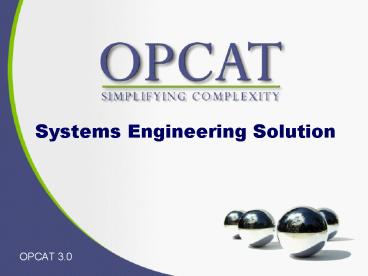Systems Engineering Solution - PowerPoint PPT Presentation
1 / 13
Title:
Systems Engineering Solution
Description:
Systems Engineering is a first, crucial phase in the development of any complex, ... early stages of requirement analysis and traversing the entire system lifecycle. ... – PowerPoint PPT presentation
Number of Views:28
Avg rating:3.0/5.0
Title: Systems Engineering Solution
1
Systems Engineering Solution
- OPCAT 3.0
2
What is Systems Engineering?
- Systems Engineering is a first, crucial phase in
the development of any complex, multidisciplinary
system. - The quality of the system design resulting from
this mission-critical phase will impact the cost
and value of the entire project!
3
OPCAT Solution
- OPCAT offers a dedicated systems engineering
solution for requirements, design, analysis, and
simulation of such complex systems. - Fast ROI is achieved by a timely prevention of
costly errors, significant reduction of
time-to-market, and improved product quality.
4
System Engineering Role
System Development Stages
SYSTEM ENGINEERING
DETAIL DESIGN
PRODUCTION INTEGRATION
TEST
- Systems Engineering encompasses
- Requirements Engineering
- System Architecture
- Subsystem Integration Design
- System Testing Design
- Project Oversight Management
Accounts for 15 of the Development Budget
5
Much of the system or products value, cost and
risk are determined here.
6
Traditional Design
SYSTEM DESIGN
DETAIL DESIGN
PRODUCTION INTEGRATION
TEST
Saved Time/Cost
System Thinking Design
Source INCOSE, 2005
7
Examples
- Systems Engineering effort led projects to
better - cost compliance
- schedule predictability
Source SECOE 01-03INCOSE 2003
8
- Success in this mission-critical phase cannot be
achieved using just
Partial solutions geared for software design UML
Administration tools that focus on workflow and
authorization
Elementary tools Like Word or Visio
You must have a comprehensive System Engineering
modeling solution
9
OPCAT Architecture
Smooth, fast, and consistent transition to
detailed design and development
Designing the system by using Object Process
Methodology (OPM) graphical and textual language
Editor
Advisor
Smart algorithm identifies design patterns and
helps implement organizations best practices
on-the-fly.
Simulator
Simulation and conceptual debugging at the design
level
- Interaction Layer
- Requirements
- Production Information
- Frameworks and Policies
Engage requirements, production information (PLM)
standards- related-information into the SE
design
Integration tests are planed as a consistent
layer on top of the system design
Integration test Planner
presentation
external objects related to the design such as
UI, JPG, Flash and physical parts are presented
together with the design
10
Main Advantages
- Clear, intuitive, consistent textual and
graphical communication language inside and
outside the organization. - A comprehensible model of the system starting
from the early stages of requirement analysis and
traversing the entire system lifecycle. - System animation and simulation for design level
debugging. - Preservation of actionable knowledge for
effective maintenance and future generations
development via OPCATs built-in evolution
mechanism.
11
OPCAT Main Outputs
Detail Design The design is transmitted by XML
to detailed design tools such as UML, BPEL,
MATLAB and CAD enabling smooth transition to the
next phases of design.
Project Management Skeleton Development tasks
are automatically exported to the organizational
project management software where resources,
cost and timetable can be added.
Product Lifecycle Management
Systems Basic physical component list (Bill of
Materials- BOM) carrying SKU is exported to the
organizational PLM systems for further handling
Knowledge Management Systems OPM blueprints
provide a common ground for system development
and reference. Embedded model-based Test Design
serve as reference for the later system
integration testing.
12
Company Profile
- OPCAT solution is based on years of research at
the Technion and MIT and has successfully been
deployed by a number of leading companies. - OPCAT Inc. was founded in 2005 in order to
transform the leading technology into a fully
commercial solution. - To date, OPCAT enjoys continuous infusion of
knowledge from the leading academic institutes.
13
For Additional Details Please contactchen.linche
vski_at_opcat.comTel 972 54 5224014
www.opcat.com































